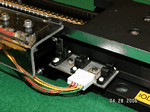APF Spectrograph Electronics
Automated Planet Finder Guide Camera Focus Stage,  EL-3512
EL-3512
Schematic: schematics\APF_guide_camera_focus_sh_1.pdf
Page last updated: January 24, 2012

Simplified Diagram - Refer to first page of schematic for more details
The APF Guide Camera Focus stage moves a TV guider camera, fed by a fixed, 4% reflectance pellicle, in and out as needed. The camera is attached to a standard THK linear stage. The stage is connected through a bellows-style coupler to an Magmotor Corporation SR15-O-200X, Rev. A DC servo motor. The motor has a US Digital model E6MD-2000-197-E encoder coupled directly to the shaft that is noted as the 'motor' encoder on the schematic. The load encoder is a Turck Kubler type T8.L2.122.1122.0005 magnetic read head with K180520 magnetic tape. The load encoder read head is mounted to the base of the stage and the tape is adhered to the bottom of the moving portion of the stage. A UCO/Lick EL-1393 Triple Hall-Effect Limit board is also mounted base of the THK stage. The board contains sensors for the forward and reverse limits and the home sensor. There are flags mounted to opposite ends of the moving stage that actuate the sensors. When moving in the forward direction, the flag on the end of the stage closest to the motor trips the forward limit at the end of travel. When moving in the negative direction the flag on the end of the moving stage furthest away from the motor will trip the reverse limit. The home sensor is located close to the reverse limit. This allows use to use one flag for both functions. A DT-2RV22-A7 DPDT limit switch is mounted near the limit sensor board. The moving portion of the stage has a notch cut out at its forward end. This notch is machined precisely to coincide with the secondary limit for reverse travel. The opposite end of the plate is machined precisely to coincide with the forward secondary limit. This allows the use of only one micro switch to signal either secondary limit. The second set of contacts on the DPDT switch are wired to the controller to indicate that the switch has been tripped. Notice that on each of the green boxes above that there is a CABLE CONNECTED signal. These signals are wired to I/O bits. When any one of the cables is disconnected the software will flag it and ask to have the condition of that cable examined.
Sheet 2  APF_guide_camera_focus_sh_2.pdf
APF_guide_camera_focus_sh_2.pdf

Simplified Diagram - Refer to second page of schematic for more details
The APF Guide Camera Focus stage moves a precision linear stage carrying the PXL. The slit decker is attached to a standard THK linear stage. The stage is connected through a bellows-style coupler to an Magmotor Corporation SR15-O-200X, Rev. A DC servo motor. The motor has a US Digital model E6MD-2000-197-E encoder coupled directly to the shaft that is noted as the 'motor' encoder on the schematic. The load encoder is a Siko MSK1000 series linear encoder. The load encoder read head is mounted to the base of the stage and the tape is adhered to the bottom of the moving portion of the stage. A UCO/Lick EL-1393 Triple Hall-Effect Limit board is also mounted base of the THK stage. The board contains sensors for the forward and reverse limits and the home sensor. There are flags mounted to opposite ends of the moving stage that actuate the sensors. When moving in the forward direction, the flag on the end of the stage closest to the motor trips the forward limit at the end of travel. When moving in the negative direction the flag on the end of the moving stage furthest away from the motor will trip the reverse limit. The home sensor is located close to the reverse limit. This allows use to use one flag for both functions. A DT-2RV22-A7 DPDT limit switch is mounted near the limit sensor board. The moving portion of the stage has a notch cut out at its forward end. This notch is machined precisely to coincide with the secondary limit for reverse travel. The opposite end of the plate is machined precisely to coincide with the forward secondary limit. This allows the use of only one micro switch to signal either secondary limit. The second set of contacts on the DPDT switch are wired to the controller to indicate that the switch has been tripped. Notice that on each of the green boxes above that there is a CABLE CONNECTED signal. These signals are wired to I/O bits. When any one of the cables is disconnected the software will flag it and ask to have the condition of that cable examined.
Sheet 3  APF_guide_camera_focus_sh_3.pdf
APF_guide_camera_focus_sh_3.pdf

Simplified Diagram - Refer to third page of schematic for more details
General stage photos:

Photo 1.
Standard APF spectrograph stage
Photo 2.
Limit component identification
Photo 3.
Forward limit flag
Photo 4.
Forward travel limit sensor
Photo 5.
In forward travel limit
Photo 6.
In forward secondary limit
Photo 7.
Reverse primary limit
Photo 8.
In reverse limit
Photo 9.
In reverse secondary limit
Photo 10.
HOME sensor
Photo 11.
In HOME sensor
Photo 12.
EL-3593 Triple limit board